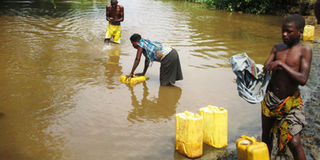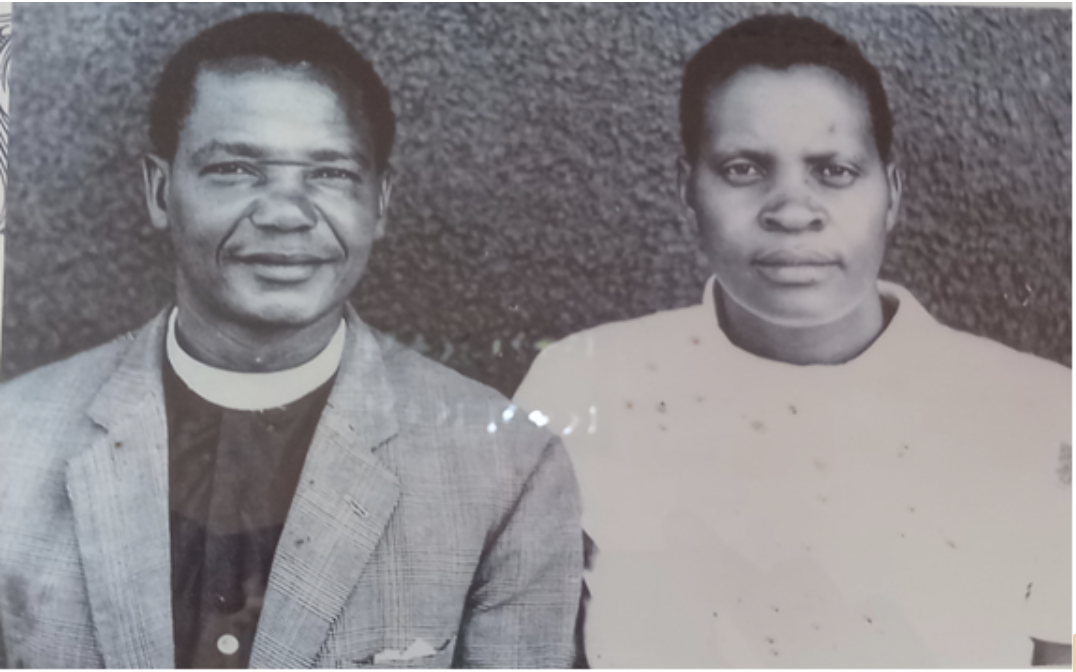Hunger bites as dry spell hits Ntungamo

Unfortunate. A woman fetches water in a jerrycan as a man (left), bathes from Mirama stream recently. Many residents of Rwentobo village in Ntungamo District use the stream as a source of water following a dry spell that has led to the drying up of water sources in the area. PHOTO BY PEREZ RUMANZI
What you need to know:
- Prolonged drought. Residents of Ruhaama County have gone without rains for more than six months. The dry spell has led to water scarcity and biting hunger compelling leaders to ask government for relief food.
NTUNGAMO. Ruhaama County has not received rains in the last six months.
This has rendered the area dry with many residents facing biting hunger, especially in Rweikiniro, Ruhaama, Ruhaama East, Kitwe Town Council and Ngoma sub-counties.
The crops that were planted in the last five months have since withered while the valley dams, wells and streams have dried up.
“We have not received any rain since early February, you can see the whole land is dry, all crops we planted never yielded and we now depend on food we buy from shops,” says Ms Allen Kyarisiima, a resident of Rwentobo village in Rweikiniro Sub-county.
She is tilling her garden hoping that rains will come mid this month so that she can plant crops again. Ms Hamida Tushemereirwe, who hails from the same area, is too preparing her garden for the coming planting season.
“I have to prepare the garden and wait. Rains only benefit those who are prepared. We just have to be hopeful. It has been a long time since we got rain. What we eat is got from Rwanda where they irrigate,” says Ms Tushemereirwe.
Kafunjo and Twempala streams, the sources of water for the residents of Ruhaama East Sub-county, have both dried up. Kafunjo was flowing from Kishami Hills joining River Mirama that feeds River Kagera.
Twempala stream that was also feeding River Mirama, has equally dried up. Consequently, the volume of water in River Mirama, the remaining source of water, has drastically reduced.
Water scarcity
River Kagera is the alternative but is located far away from many of homes. Some residents walk more than 8kms to fetch water from River Mirama.
Due to water scarcity, Mr Moses Mugabe, the Rwentobo Village chairperson, says residents, especially women, trek in groups in search of water.
“Women walk in numbers of eight to 20 to fetch water. They start the journey early morning. This is because the journey is long and tiresome and the weather is hot. It’s about five miles from here,” Mr Mugabe says.
River Mirama forms Uganda-Rwanda boundary. Rwanda government taps the water which is used to irrigate people’s gardens for better yields.
There are several stores of beans and other food stuffs in Kigando Trading Centre on the Ugandan side.
However, this produce is not grown in the area; it comes from Rwanda side, thanks to the irrigation scheme. Mr Mugabe says while crops in Rwanda did very well due to irrigation, farmers on the Ugandan side posted poor harvest for beans, cassava, maize, groundnuts and sweet potatoes. Banana yields have also been poor due to the prolonged drought.
More than 80 per cent of the 538 households in the village can only manage a single meal a day because of the prevailing circumstances.
Rweikiniro Sub-county chairperson Misach Kahinda says many of the homes need food relief to take them through the dry spell and first weeks of rainy season.
“The situation is terrible. Government needs to come in and help, people are so hungry. We cannot afford to have people die of hunger here, I think government has a way it can help,” says Mr Kahunda.
Mr Jamil Mparana, a resident, says the government should emulate Rwanda and start irrigation as well as supply safe piped water to the residents.
“We use the same river; Rwanda uses it for irrigation, for us our crops are drying. Rwanda taps water for household supply for us we use jerrycans. Our government should give us the similar services,” says Mr Mparana.
In Kitwe Town Council, particularly Kibutamo, signs of desperation are vivid. There is hardly any green vegetation in the area. The ground is bare. Residents claim, so far, five of their fellow residents have died of hunger.
Drought
The district councillor for Ngoma Sub-county, Mr Dan Butera, says areas of Kashenyi, Kizinga, and Nyakariro have been severely hit by drought triggering lack of water and pasture.
The area is predominantly occupied by cattle keepers and animals are dying. Some cattle keepers have started migrating in search of pasture and water, which according to Mr Butera, had never happened in the areas in the last 20 years.
Mr Denis Singahanche, the district chairperson, says more than 21,000 households in the four sub-counties (Rweikiniro, Ruhaama, Ruhaama East, Kitwe Town Council and Ngoma) are currently food insecure and that there is need for central government intervention. He, however, blames the crisis on degradation of wetlands.
“Many of these places facing severe drought had wetlands, people descended on them and reclaimed them, and there is no single wetland left now. They have experienced the worst dry spell in more than 30 years and they will still get more challenge, especially when rains come,” says Mr Singahanche.
He adds: “As we call on government to give them relief food, we also want them to use their land sustainably. We can’t afford losing more wetlands and have more people crying. We will now embark on sensitising these people to plant more trees to save the environment.”
Ms Dinah Tumwebaze, the Ntungamo District environment officer, says while rains are expected soon, the affected areas always experience low amounts of rain. This, he said, is the reason for the high crop failure.




